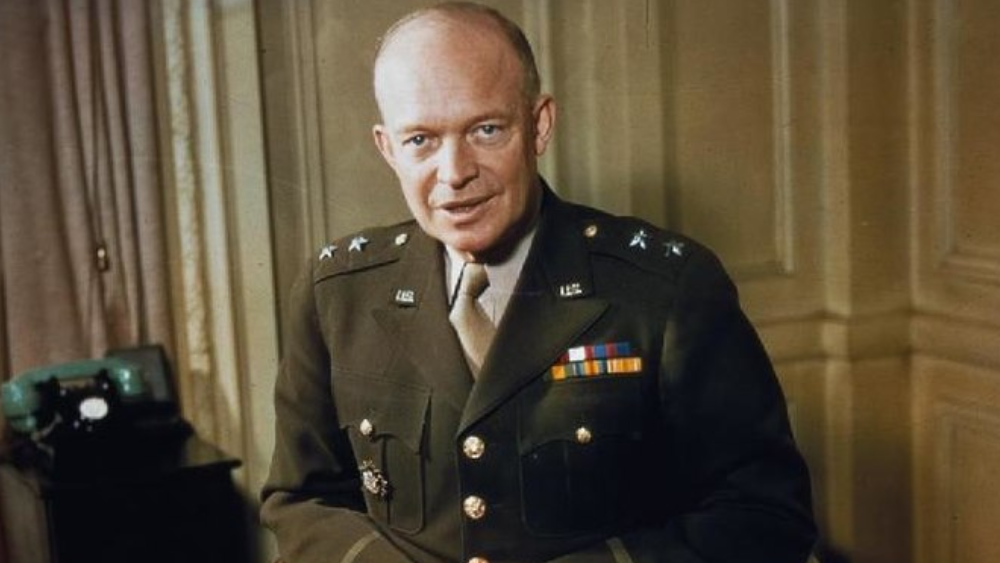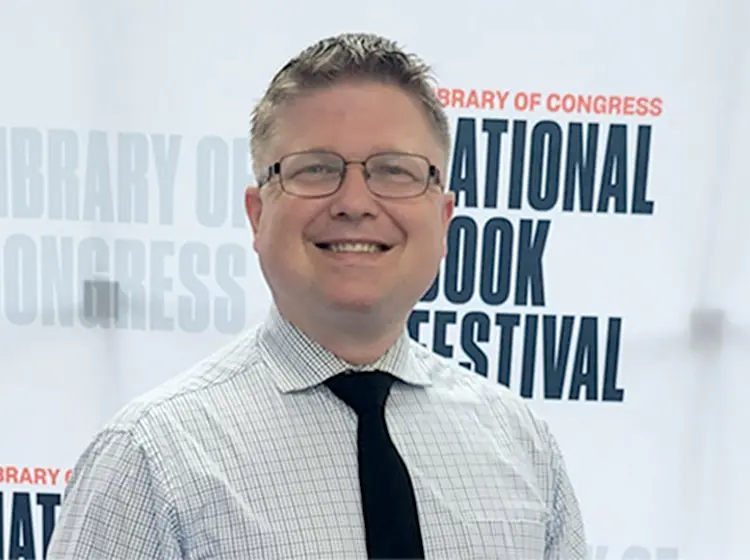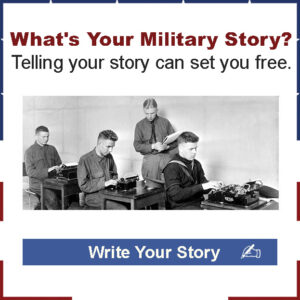Dwight D. Eisenhower, born on October 14, 1890, in Denison, Texas, was a military leader and statesman who played a pivotal role in both World War II and the early years of the Cold War. As the 34th President of the United States, Eisenhower’s leadership, strategic insight, and diplomatic skills made a lasting impact on American history.
Early Life and Military Career
Dwight D. Eisenhower’s journey began in the humblest of circumstances. Born into a family of limited financial resources, he harnessed his innate talents and determination to rise above his origins. Excelling academically and athletically, Eisenhower’s diligence secured him an appointment to the U.S. Military Academy at West Point. His graduation in 1915 marked the beginning of a military career that would go on to make a lasting impact on history.
In the years leading up to World War II, Eisenhower’s dedication and capability were evident as he undertook various assignments. Burgeoning leadership and organizational skills set him apart, foreshadowing his pivotal role in 20th-century conflicts. Eisenhower’s early military journey showed resolute commitment, laying the groundwork for transformative moments on the global stage that awaited him.
Dwight D. Eisenhower: World War II Leadership
Dwight D. Eisenhower’s ascendancy to international acclaim reached its zenith through his remarkable leadership during World War II. Appointed as the Supreme Commander of the Allied Expeditionary Force, he embarked on an unparalleled endeavor that would reshape the course of history. At the helm, Dwight D. Eisenhower orchestrated the audacious D-Day invasion of Normandy on June 6, 1944—an operation of unparalleled complexity and scale. Strategic acumen, meticulous planning, and forging cohesion among allies led to a resounding victory, pivotal in the war effort. Normandy success weakened Nazi control, paving Western Europe’s liberation, highlighting Eisenhower’s visionary and resolute leadership in the military.
Moreover, Dwight D. Eisenhower’s indomitable leadership extended beyond the battlefield as he navigated intricate political landscapes and fostered unity among allied nations. His adept diplomacy and collaborative spirit fortified the coalition’s resolve, proving crucial in the defeat of a common enemy. His WWII leadership’s profound impact resonates, exemplifying his capacity to rally nations and shape continents’ destinies across time. Eisenhower’s legacy endures as a leadership paragon in a defining era, showcasing the transformative potential of resolute, visionary leadership.
The Cold War Begins: NATO and Containment
In the aftermath of World War II, Dwight D. Eisenhower’s influence on global affairs remained pivotal. The ascent to NATO or the North Atlantic Treaty Organization’s first Supreme Allied Commander marked a defining post-war geopolitics moment, shaping the international landscape. Tasked with uniting Western nations against the looming specter of Soviet expansion, Dwight D. Eisenhower’s leadership within NATO underscored his dedication to the principles of collective defense and containment. Under his guidance, the alliance solidified mutual security commitment, standing united as a formidable Cold War ideological bulwark.
Dwight D. Eisenhower’s strategic acumen within NATO was a testament to his far-reaching vision. His steadfast leadership and emphasis on cooperation reinforced the alliance’s resilience, serving as a deterrent against potential aggression. Amid the Iron Curtain’s descent, Eisenhower’s containment commitment extended beyond military strategy to curb communism’s spread comprehensively. Eisenhower’s North Atlantic Treaty Organization role left a lasting imprint on geopolitics, showcasing his unity-forging capacity amidst uncertainty. He laid the foundations for complex international relations.
Dwight D. Eisenhower: Presidential Aspirations and Election
Dwight D. Eisenhower’s sterling record as a distinguished military leader became a launchpad for his foray into the realm of politics. The year 1952 witnessed his entrance into the presidential race as a candidate under the Republican banner. With an esteemed military background, Eisenhower campaigned on stability and resolute leadership promise during a complex, uncertain global landscape. The transition from the military to the political arena highlighted his unwavering commitment to serving the country in conflict and peace.
Dwight D. Eisenhower’s resounding victory in the 1952 election inaugurated his tenure as the 34th President of the United States. His presidency, which spanned two terms, was marked by his distinctive approach to governance—a blend of pragmatism, diplomacy, and a deep understanding of the international complexities that defined the era. His election not only solidified his reputation as a leader of exceptional versatility but also marked a pivotal juncture in American history, as the nation looked to his steady guidance to navigate the intricate challenges of the Cold War and domestic affairs.
Dwight D. Eisenhower: The Cold War Escalates: Crises and Strategies
Dwight D. Eisenhower’s tenure in the White House unfolded against the backdrop of intensifying Cold War tensions, punctuated by pivotal moments that showcased his adept handling of global crises. The 1956 Suez Crisis stands out as a testament to his diplomatic finesse and commitment to upholding international norms. In the face of a volatile situation in the Middle East, Eisenhower skillfully navigated the complexities, standing firm in support of international law and diplomacy. His decisive actions not only diffused the crisis but also underscored America’s role as a stalwart advocate for peaceful resolution in the international arena.
The Cold War rivalry took an audacious turn with the Soviet launch of Sputnik, the first artificial satellite, in 1957. Eisenhower’s response to this technological milestone was emblematic of his visionary leadership. Recognizing the significance of scientific advancement and its implications for national security, he embraced the challenge by fostering a renewed commitment to scientific research and education. This commitment materialized with the establishment of the National Aeronautics and Space Administration (NASA), a transformative agency that would redefine America’s capabilities in space exploration and technology.
Eisenhower’s response to the Sputnik launch showed his talent for turning challenges into opportunities for progress. His leadership left a lasting impact on the nation’s scientific advancements. He guided the U.S. through a time of rapid global change, reinforcing his legacy as a strong and forward-thinking leader.

Farewell Address and Legacy
President Dwight D. Eisenhower’s farewell address in 1961 left an enduring imprint on the American collective consciousness. In a speech that would become iconic, he issued a solemn caution against a formidable adversary of a different kind—the “military-industrial complex.” His prescient warning illuminated the potential pitfalls of unchecked collaboration between the defense industry and government entities. Eisenhower sounded the alarm about the risks posed by the undue influence of this complex on policy decisions, expressing concerns that such a dynamic could jeopardize the integrity of the nation’s democracy and its commitment to the welfare of its citizens.
Eisenhower’s farewell address not only spotlighted the challenges of his era but also resonated as a timeless call to civic responsibility and vigilance. His words still echo through history, reminding Americans of their duty to uphold the principles on which the nation was founded. His parting message serves as a steadfast reminder that the strength of democracy hinges on the informed and engaged participation of its citizens, safeguarding against the encroachment of interests that may compromise the welfare of the nation. Eisenhower’s legacy as a leader extends beyond his impactful policies and international diplomacy. It also encompasses his commitment to transparency, accountability, and the enduring pursuit of a government that is truly “of the people, by the people, and for the people.”











[…] corresponded with and influenced a generation of military leaders, including prominent figures like Dwight D. Eisenhower and Heinz […]
[…] career took a pivotal turn in 1964 when he joined the Eisenhower Papers project, working closely with World War II historian Forrest […]